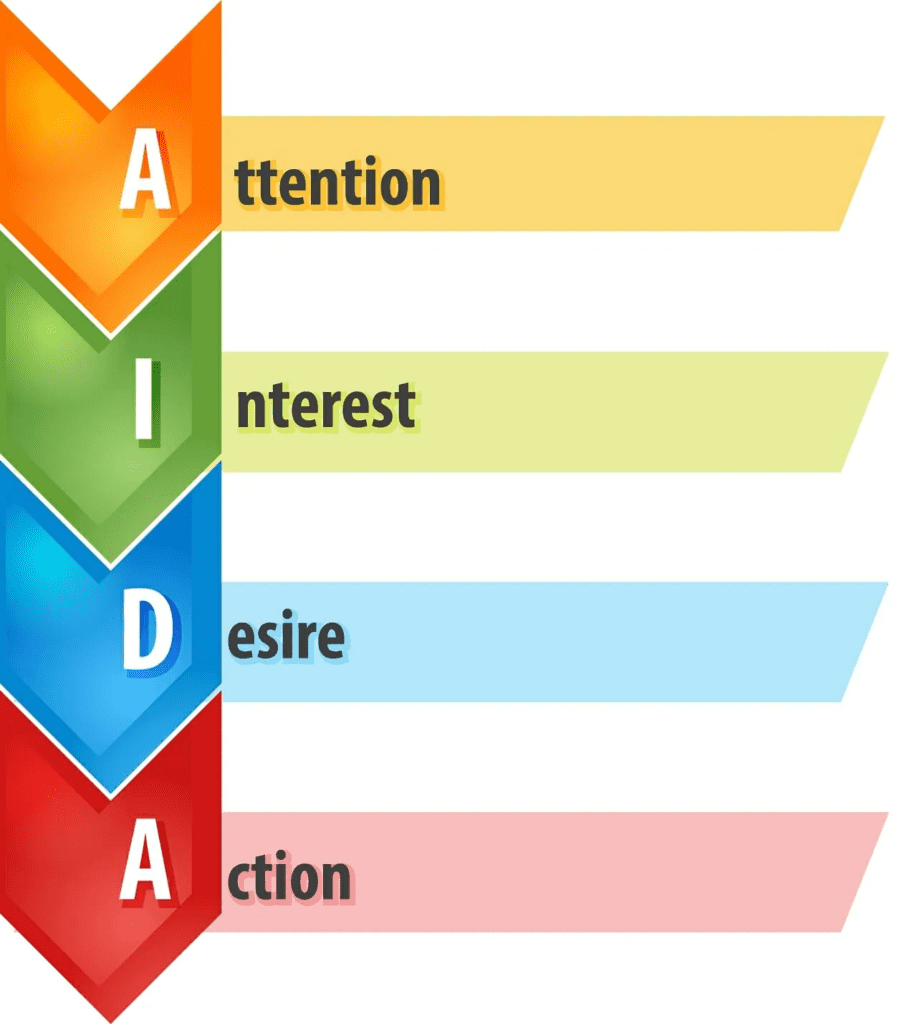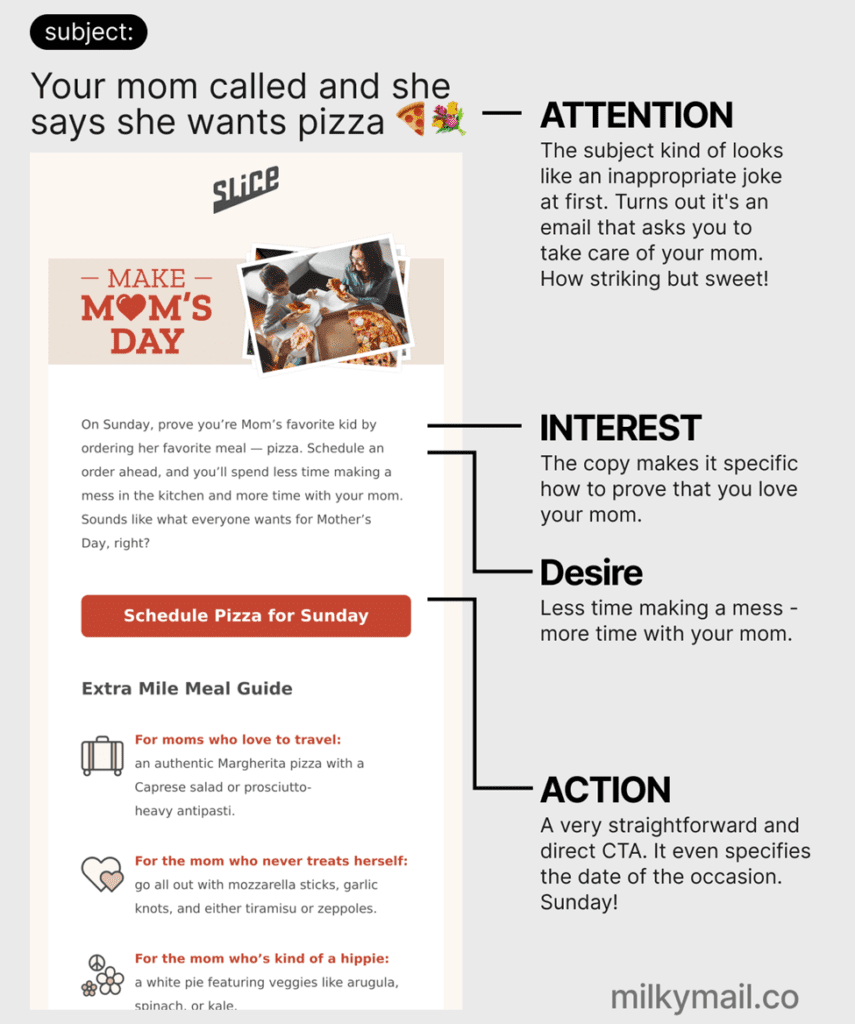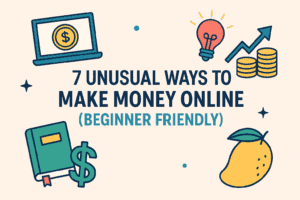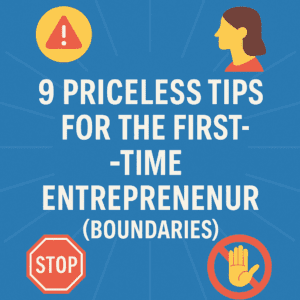Have you been hearing a lot about the AIDA formula and are confused about how to use it? Would you like to see an example of how to use it properly? In this article, I will give a thorough breakdown of the AIDA strategy, especially as it is used for email copies.
I will also provide great examples of how this email copywriting method was used properly and best practices. If you read to the end, you will have a perfect idea of how to structure your email, even as a beginner using this method.
What is the AIDA Formula in Copywriting

The AIDA method was first introduced in 1800 as one of the best marketing strategies to get your audience’s attention and lead them to action.
AIDA stands for Attention, Interest, Desire, and Action. This strategy is efficient from the midlevel to the final stage of the consumer journey, as there is already a little information about your ideal audience and what they may want.
This is essential, as the best way to incorporate this is to ensure that your message is properly personalized, as your attention trigger would work for everyone.
From Attention to Action: Breakdown of the AIDA Journey
I explained each part of the AIDA formula in detail so you would have a concrete idea of its purpose.
Attention
The first step in incorporating the AIDA strategy is attention. Attention is a trigger that would make your reader pay attention to you or open your email.
This part is mostly the subject of your email, and knowing how many emails people get a day, you need to ensure that your attention trigger stands out and makes them click to open the email.
A good way to do this is to do proper research and fully understand what serious problem your potential audience would want to solve that would make them consider your brand.
Also, consider emotion-triggering words that may be linked to that issue and consider using them while still maintaining your brand voice.
Interest
In the interest stage, the goal is to keep their attention after you have gotten it. One of the best ways to achieve this at this stage is to illuminate the problem.
Show them more ways why the problem of why they clicked into your email may be a bigger issue. Your goal here is also to grow their interest in finding the solution to these problems, which should be something you can offer.
When illuminating the problem, you should focus on things that matter to your audience based on your research, and it should be a problem you can solve, though, at this stage, you are not yet talking about the solutions you bring to the table.
Desire
Now that you have fixed a big problem in your audience’s mind that needs solving, what is next? You provide the solution.
Here is the part where you talk about your brand’s product or services, focusing on its benefits to your audience based on the abovementioned problems.
One method that also works here is using social proof to show how other people have used these products to solve the issues you mentioned and how their lives have improved.
People can be very skeptical, especially with a first purchase with a brand, so providing user reviews and these social proofs would go a long way to kill any doubts they may have about your product.
Action
In the moment of truth, you need your audience to act. You need to be clear about what action you would want them to perform and also use some strategies that they actually go through with your desired action, either buying your product or services or whatever your priority is at the time.
You could incorporate psychological triggers like urgency by providing a limited edition of your product or discounts only valid for some days. This way, you ensure that your efforts in getting your audience to this stage are not wasted.
Two Examples of AIDA in Email Copywriting
These two examples have been broken down to ensure that you understand the role of each part, from attention to action.
Example 1: Mother’s Day email from a Pizza Store

The email started with an attention-grabbing headline, though the joke is slightly distasteful. It does make you want to open up and find out what these people are all about.
Next, they grab your interest by suggesting you celebrate your mother on Mother’s Day with a pizza date. So they aren’t weirdos after all, not bad!
Then, they offer you an opportunity to celebrate your mom with some extra convenience—without making a mess in the kitchen—by just getting the pizza from them.
Finally, they request action by providing a clear call to action. They even gave recommendations based on Mom’s possible character types to help you make better choices. Great copy!
Example 2: Web analytics service email

This email targets business owners or anyone with an active website. The focus is on the 40% loss of website traffic, which would immediately scare any business owner. Now, they want to know what this person is talking about. Mission accomplished, attention grabbed!
Now, they build on this by explaining why their audience’s website may be losing traffic using statistics. This method holds their attention by growing their interest and opens the way to building desire.
At the desired stage, they make the reader aware that they have technical know-how when solving this problem.
Since the desire-building period was very short, they offered free services in their action offering to build trust. Their call to action was for the potential lead to book a free website analysis, and they added the price so the client knew what they offered for free. So, the lead would want to accept the offer.
From their report, if the client sees the problem, they could be paid to optimize the website for mobile viewing.
Conclusion
Providing structure with your copies is one of the best ways to create copies that convert faster. That is one thing the AIDA method offers for you. After performing the necessary research as a copywriter, you could line out the words and fill out each part with words that could drag your users to the next stage of their buying journey.
With good enough practice, the transition would be so smooth no one could notice the switch. You can practice the method further and comment on your results below.
Lastly, check out my other blog post on sales and copywriting tips. Happy selling!




This piece has a beautiful rhythm, like the gentle unfolding of a story that you don’t want to end.